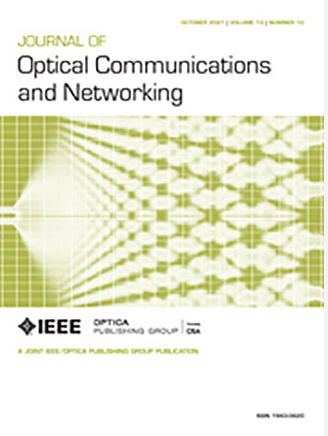具有远程控制和管理技术的城域/接入融合全光子网络,可容纳各种类型的终端[特邀]
IF 4
2区 计算机科学
Q1 COMPUTER SCIENCE, HARDWARE & ARCHITECTURE
引用次数: 0
摘要
将密集波分复用(DWDM)城域网络扩展到接入区,使网络运营商能够在接入区和城域之间提供灵活且可重构的端到端光路径,以支持具有严格带宽和延迟要求的新兴用例。光网络架构的这种演变也将有助于解决与全球变暖危机相关的社会问题,因为它降低了光/电转换和接入/城域边界的电处理的功耗。主要从物理层端到端主信号传输的角度出发,基于这种架构演变的全光子城域/接入融合网络(apn)已经得到了积极的实现。本文从不同的角度探讨了研究的必要性。为了将APN的覆盖范围扩展到网络运营商大楼外的接入区,光路控制和管理的技术创新是必不可少的,特别是从远程终端控制和管理的角度。我们概述了三个主要的技术挑战:建立远程控制通道、管理访问端的端口和阻止非法远程终端。本文首次提出了最后一个技术难题,并提出了一种解决方法。我们通过使用APN接入节点(定义为光子网关(GW))和APN控制器的原型进行实验演示,全面确认了每种方法应对这三个技术挑战的可行性。Photonic GW原型机采用10千兆对称无源光网络,用于远程终端的通道内控制,无论类型如何,并解决了第一个技术挑战。APN控制器实现了用于初始终端连接方法的序列,以解决第二个技术挑战,以及用于光路设置的序列,包括用于检测和阻止不正确光的提议方法,以解决第三个技术挑战。当新的100gb /s c波段DWDM数字相干远程终端连接到光子GWs时,APN控制器执行序列集的周期仅为18s,这对于建立光路之前的处理来说足够短。只有在验证新的远端终端的光功率和发射波长正确的情况下,基于在初始终端连接过程中确定的远端终端与光子GW之间的接入侧连接,才能自主建立通过两个光子GW原型的端到端光路。本文章由计算机程序翻译,如有差异,请以英文原文为准。
Metro/access converged all-photonics networks with remote control and management technologies accommodating various types of terminals [Invited]
Extending dense-wavelength-division-multiplexing (DWDM) metro networks to access areas enables network operators to provide flexibly and reconfigurably end-to-end optical paths across access and metro areas to support emerging use cases with stringent bandwidth and latency requirements. This evolution in optical network architecture will also contribute to addressing social issues related to the global warming crisis by reducing the power consumption of optical/electrical conversion and electrical processing at access/metro boundaries. Active efforts have been made to actualize all-photonics metro/access converged networks (APNs) based on this architecture evolution mainly from the perspective of end-to-end main-signal transmission in the physical layer. This paper discusses the need for studies from a different perspective. To extend APN coverage to access areas outside network operator buildings, technological innovation in optical path control and management is essential especially from the perspective of remote terminal control and management. We overview three main technical challenges: establishing a remote-control channel, managing ports on the access side, and blocking rogue remote terminals. The last technical challenge is raised for the first time in this paper, and an approach for addressing it is proposed. We comprehensively confirm the feasibility of each approach to the three technical challenges through experimental demonstrations using prototypes of an APN access node, defined as a Photonic Gateway (GW), and the APN controller. The Photonic GW prototype employs a 10-gigabit-capable symmetric passive optical network for in-channel control of remote terminals, regardless of the type, and addresses the first technical challenge. The APN controller implements a sequence for the initial terminal-connection method to address the second technical challenge, and a sequence for optical-path setup including a proposed method for detecting and blocking incorrect light to address the third technical challenge. When new 100-Gb/s C-band DWDM digital coherent remote terminals are connected to the Photonic GWs, the period for the APN controller to execute the set of sequences is only 18 s, which is sufficiently short for the process before optical-path establishment. Only when the optical power and emission wavelength of new remote terminals are verified to be correct, an end-to-end optical path passing through two Photonic GW prototypes is established autonomously based on the access-side connectivity between the remote terminal and Photonic GW, which is identified during the initial terminal-connection procedure.
求助全文
通过发布文献求助,成功后即可免费获取论文全文。
去求助
来源期刊
CiteScore
9.40
自引率
16.00%
发文量
104
审稿时长
4 months
期刊介绍:
The scope of the Journal includes advances in the state-of-the-art of optical networking science, technology, and engineering. Both theoretical contributions (including new techniques, concepts, analyses, and economic studies) and practical contributions (including optical networking experiments, prototypes, and new applications) are encouraged. Subareas of interest include the architecture and design of optical networks, optical network survivability and security, software-defined optical networking, elastic optical networks, data and control plane advances, network management related innovation, and optical access networks. Enabling technologies and their applications are suitable topics only if the results are shown to directly impact optical networking beyond simple point-to-point networks.

 求助内容:
求助内容: 应助结果提醒方式:
应助结果提醒方式:


